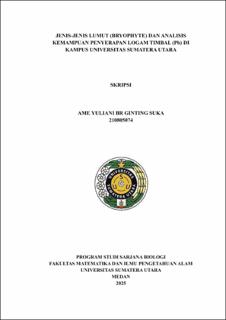| dc.description.abstract | Universitas Sumatera Utara (USU), located in the center of Medan City, serves
as a center for educational activities, making it a place that has a quite high volume
of motor vehicle traffic, which contributes to the risk of heavy metal pollution,
particularly lead (Pb). Although studies on epiphytic moss species have been
conducted in the USU area, but the full diversity and the specific species' ability to
absorb Pb have not been comprehensively identified. This study aimed to identify the
moss species found within the Universitas Sumatera Utara campus and to analyze
their capacity to absorb lead (Pb). The research was conducted from November 2024
to May 2025 using an exploratory method at 19 sampling locations. Lead content in
moss samples was analyzed using Atomic Absorption Spectrophotometry (AAS) at the
Medan Industrial Standardization and Services Center Laboratory. The results
identified 23 moss species classified into three divisions: Marchantiophyta (%
families, 11 genera, 13 species), Bryophyta (5 families, 7 genera, 9 species), and
Anthocerotophyta (1 species). The species with the highest Pb absorption capacity was
Isopterygium minutirameum (37,1 mg/kg), while the lowest was Octoblepharum
albidum (4,53 mg/kg). | en_US |


